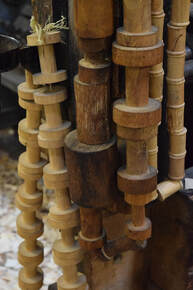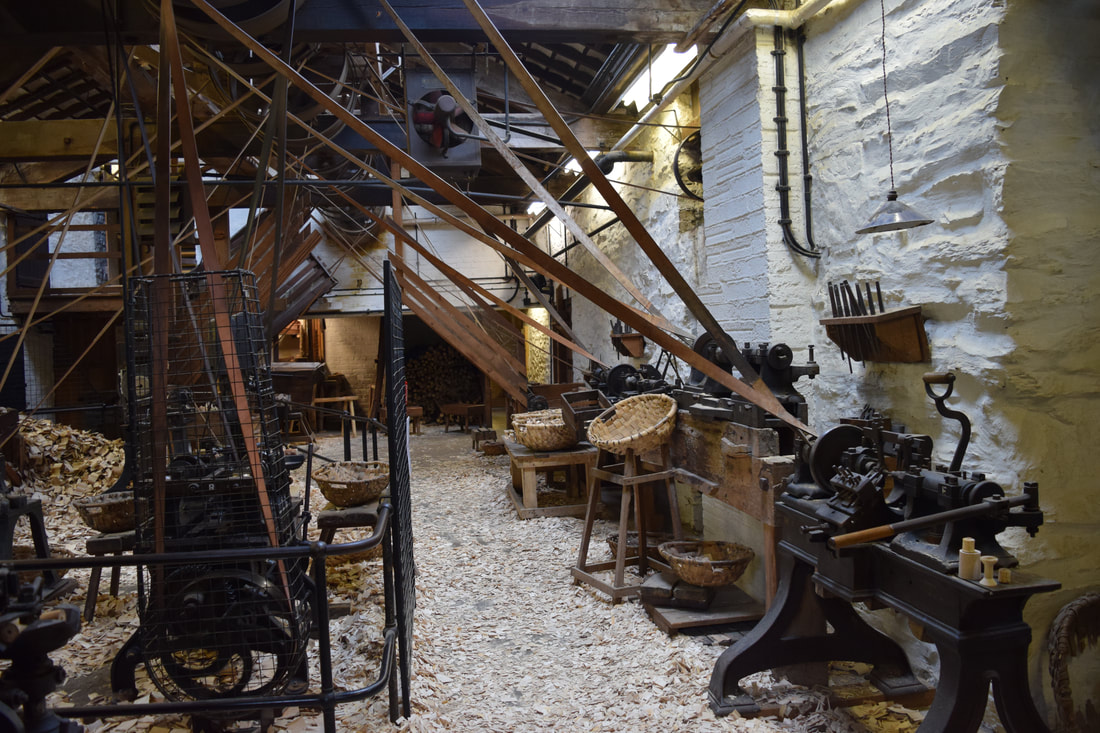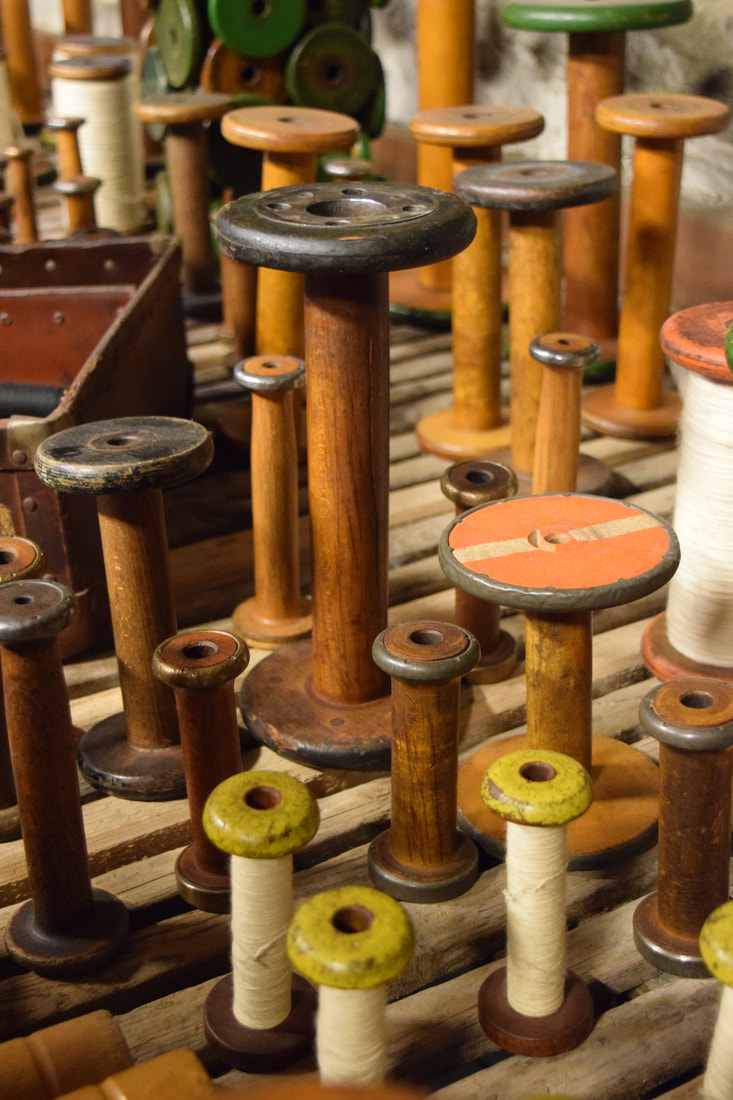Stott Park is now the only surviving example of a working bobbin mill. The Lake District was a perfect area for bobbins mills which fed the busy industrial cotton mills in Lancashire, which the area was then part of. The area suited the mills perfectly with a good source of power from the many streams and a constant supply of wood from coppiced woodland. The mill was given to English Heritage in the early 1970’s by the owners who had the foresight to see that not only was the mil not sustainable any longer but also that it should be preserved for future generations as a mark of Lakeland history. To fully see the mill you need to go on one of their guided tours which takes you around the main mill building. These run every hour from 10.30am. The two ladies who showed our group around were so knowledgeable and brilliant at explaining the history, answering questions and importantly showing us how the machines worked. Ahead of my arrival I didn’t know about the tours, I probably should have read my English Heritage members guide more carefully but I timed it well so we arrived just as it was starting. It took about 45 minutes to go around the main mill building and see each section on both floors as well see how three different original machines worked.
John Harrison who was part of an established local family advertised for a tenant to take on the recently constructed mill building in 1835. It remained in the family until around 1867, being let to varying tenant bobbin masters, who ran the mill as successful businesses. The Coward family, another local family from Skeltwith Bridge who, since the 1850’s, had already gained two other bobbin mills, took on the mill and continued to run it until it finally closed in 1971. The mill was built in 1835, and has lots of windows on the first floor to allow as much light as possible for those working. During the 1870’s and 1880’s when Coward family had taken it over, the mill had several extensions and additions. The new ground floor lathe shop and the steam engine were the main elements of this modernisation of the mill. Stott Park was a mechanised mill where coppice poles were turned into finished bobbins and sent to the textiles industries throughout the world. I knew nothing of bobbin making before my trip and thanks to the fantastic guides I came away knowing so much! Several processes are involved in making a bobbin, and each man had his own job. many of the men working in the mill would have kept the same job for the time they worked there – some still working the job after 30 years! The first room had cobbled floors and as you enter the main building the floor is strewn with wood shavings, sawdust and every corner is filled with machines, tools, baskets of bobbins, swill baskets, piles of wood. It already seems like a busy working mill, but now imagine that at one time the mill would have had around 250 men and boys working there (and in its history one woman) and you start to imagine how cramped the working conditions must have been and how busy even this fairly small mill would have been on a daily basis.  On the ground floor, you first come to the circular saws when the wood is chopped into the size pieces to make the bobbins. Also here is the blocking machine which came in later in the 19th century and also chopped the wood into smaller blocks. The engine room still houses the original steam power engine built between 1870 and 1880. At the rear of the building is the New Lathe Shop which was built in the 1870’s and allowed for more space and more machinery to increase production, it was the last major improvement to the original mill. Here there are several machines such as the hand boring machine which created the central hole in the lumps of wood. The rough lathe which turned the blocks into the rough size and shape of the bobbin. One of the guides demonstrated this and made several bobbins which she then took to the next stage which involved smoothing them and creating the finished shape and size on the finishing lathe.
The mill made bobbins of all shapes and sizes, and in one of the upstairs rooms there are many many bobbins on display showing the different shapes and sizes that were used in the textiles industry. The larger ones tended not to be made from one piece, but instead were made from several pieces joined together. As the years progressed and the demand for bobbins changed due to the use of plastic and metal, the mill expanded into making other products such as yoyo’s and spindles.
Child labour during the Victorian period was rife and the mill employed a number of children to do varying jobs. Some of the boys came from the local workhouse and some as young as 8 were employed until the Factory and Workshop Act of 1878. After this Act, boys of 10 were the youngest that could, in theory, work in any factory. There were jobs that the boys were mainly given to do such as putting on glue, sorting the bobbins, climbing into the rafters to fix machinery and oil the belts, carrying away sawn pieces of wood, boring holes in the wood and cleaning them out. The guide book tells of stories where children had accidents due to working with the machinery as well as the story of a boy who was sent on an errand across the fells in winter and never returned, dying from hypothermia. Outside, spend some time in the remaining barn which has a lot of information on the history of the mill. The drying barn is worth a look as is the old blacksmiths which was in a separate building to reduce the risk of fire with all the dry wood and sawdust flying everywhere in the main mill building.
I really do recommend taking a visit here and finding out about it for yourself. Around an hour is all you need for the tour and a walk around the barn and outside and so couple easily be combined with other adventures on your day out. We went onto to have a nice walk at Tarn Hows and then finish the day with a visit to Hawskhead and dinner there before heading home just as the sun was setting around 6.30pm.
Visiting The mill is now closed until the end of March but then reopens for the Spring and Summer season. Visit the English Heritage website for further details. http://www.english-heritage.org.uk/visit/places/stott-park-bobbin-mill/ Finsthwaite, Ulverston, Cumbria, LA12 8AX
3 Comments
 The Industrial Revolution, James Lowe and Henrietta Vansittart When you think of the Industrial Revolution what images do you conjure up? For me its the hardship and bleakness of smoke infested towns, enormous brick buildings pumping, whirring, grinding and shunting - coal, tin, wool, cotton, iron and steam. But it’s not only the bleakness of the places, it's also the bleakness of the people - lined, weary faces of those trying to many a penny to survive, fresh faced excitement of those arriving from the countryside, and aristocratic men, in crisp, starched shirts and waistcoats inventing and creating new and even more fabulous inventions. Henrietta Vansittart was revolutionary in that she was one of the only great female engineers of the Industrial Revolution. James Lowe was one such inventor. Lowe had worked as a mechanist and smoke jack maker and invented a screw propeller for ships. On 23 March 1838, he took out a patent for a new screw propeller which ensured his place in history. New inventions were taken to the Royal Navy weekly, and at this time there was very little money to be made from such things. But Lowe would not give up and he spent all his wife's money on his experiments and a succession of patents reducing the family to complete poverty by the early 1850's. Therefore, it might seem strange, that his daughter, Henrietta Vansittart (nee Lowe) excelled herself to become a respected engineer and inventor in her own right, at a time when Victorian women should have been doing anything but science. Henrietta Vansittart Nee Lowe Henrietta was born in 1833, to James and Marie Lowe (nee Barnes) - she did not have the most fortunate of circumstances, she was the third daughter of six sisters and two brothers, and her father had almost bankrupted the family by 1852 through his desire to invent. However, Henrietta it seems was a social climber and had dreams of grandeur, and by 1855 she had married a lieutenant in the 14th Dragoons, Frederick Vansittart who had been based in Paris. Soon after they bought a house in Clarges Street, London and it seems he sold his commission to they could set up home. But, this was not good enough for Henrietta and in 1859 she started an affair, which lasted 12 years with the novelist and politician, Edward Bulwer Lytton. Lytton was a man of high social status and Henrietta clearly had an effect on him, although perhaps not to Disrealis liking and is said to have blamed Lyttons absences from the House of Commons on his association with Henrietta. Lytton became ill and in 1873 died, leaving Henrietta £1200 in his will and very oddly her husband, £300. She returned to her husband and lived in Twickenham. Henrietta was clearly a highly charismatic and feisty young lady who knew what she wanted and did not allow things to stand in her way. (Image 1 - see source During this time, Henrietta took a keen interest in her father’s work and accompanied him on the HMS Bullfinch in 1857 to test out the new screw propeller. She had her own ideas for how it could be developed, and after her father was tragically killed by a cart crossing the road in London in 1866, she took on her father’s work without any formal scientific or engineering training. Within 2 years she had patented another propeller to allow ships to move faster and smoother and use less fuel. In 1868, the Vansittart Propeller was patented and was used on HMS Druid - she won numerous awards for this, had articles written on her in the Times Newspaper and attended exhibitions all over the world. She was clearly a remarkable woman. It is believed that she was the only lady who ever wrote, read and illustrated with her own drawings and diagrams a scientific paper before members of the Scientific Institution. Henrietta and Twickenham Of course, no street or person would be complete without some intrigue, mystery and scandal and Henrietta certainly had some interesting moments. It is one of my favourite things about researching a house history – the stories of the people who lived there. The little scraps that give us a glimpse into the past – of squabbles and stand offs, intrigue and intellect, parties and politicians. Montpelier Row has certainly had its fair show of arguments, Henrietta seems to have lived a colourful life in all areas. It is perhaps strange that she left her husband to have her affair with Lytton in this age, and that Lytton then left both Henrietta and Frederick money in his will, £1200 to her and £300 to him, no small sum in 1873. Stranger still perhaps that she then went back to her husband. Happily or not, who knows. They appear to have become property owners, owning a number of houses in Montpelier Row Twickenham as well as on Maids of Honor by Richmond Green. These were, and still are desirable addresses. The 1871 census lists them at 4 Maids of Honor Row although records suggest she was there in 1869 without her husband. Perhaps she had bought it with funds from her patent or from Lytton. Henry George Bohn in a letter to the Richmond Twickenham Times in 1879 states that she arrived in Twickenham around 1874. In a later letter by Bohn he talks about 4 houses that she had purchased and which had then been converted into two, these appear to have been Number 4 and 5 which later became Seymour House and 1 and 2, which were known as Bell House and St Maur’s Priory. It seems by 1880 she had No 1, St Maur’s Priory (Which had been named by her) and 2, Bell House left in her possession as she had sold the others off. The 1881 census, shows that Frederick and Henrietta were living at No 1 Montpelier Row whose main frontage was on the Richmond Road. In 1878, Bell House, Number 2 was offered for lease for the sum of £100 and Seymour House, Number 3 was also offered for sale for £73,10s. Both properties were owned by Henrietta at this time and were offered for sale by Mr Fowler on 25 June 1878. It appears that a neighbour, Henry George Bohn, the infamous fine art dealer, publisher and book collector, with whom there seems to have been some rivalry and dispute purchased Seymour House from Henrietta in 1879, paying £1100.00 – a vast increase on the alleged two hundred pounds she had spent only a few years earlier. Henry George Bohn was the Vansittarts neighbour, living at North End House, just the other side of the Richmond Road. There appears to have been a great deal of rivalry amongst the two households, not least perhaps because of Henrietta’s desire to own and lease property – the same property that Bohn also wanted to own and lease. There was some argument with the local council in 1879, as the row had been changed to Montpelier Row to which Bohn took great displeasure and wrote to the Richmond Twickenham Times.(5) He had erected a sign on the from of the wrought iron railings of No 1, Henrietta’s house which stated Montpelier Row, He claims this had been agreed with Henrietta and that they had been on speaking on terms about it. However, to his annoyance, early one morning he had spied from his house, Mr Vansittart at the top of a ladder, painting the sign out! I can quite imagine the surprise and intrigue of curtains twitching as the early morning sun rose in Twickenham, to reveal an ageing Mr Vanisttart balanced among the top of a ladder, with an incensed wife in her long skirts, swishing in the dust at the bottom issuing her instructions. Bohn took to paper soon after, seemingly to air his grievances about Henrietta in public – entitle ‘The Montpelier Row Difficult’, he writes that: ‘It is with great regret that I find myself brought once more into a verbal conflict with Mrs Vansittart, but she is inexorable, and by way of publicly introducing, what appear to me to be mere figment of the brain, contrives to make me the scapegoat. I have no choice, therefore, but to reply to her, and bring out what may well be called the facts of a Tweedledum affair’ (6) It seems that Henrietta had claimed that she had thousands of pounds on improving the row, both the buildings she had purchased but also the area of land opposite, which Bohn claims that he had in fact sectioned off and made good to stop costermongers and other nuisances taking over. She stresses that she has done so much more for the neighbourhood than Bohn has ever done – keeping up with the Jones of the Victorian age. He also airs in public his annoyance at her private affairs about the purchase and sale of her properties, and mortgages she had taken out. Indeed, what obviously had been private discussions seems to have reached a head in 1879/1880 as both wrote backwards and forwards to the paper airing their grievances of one another’s behaviour over several years. A very public affair! Sadly Henrietta met a very unhappy end. In the autumn if 1883, it seems she was attending the North East Coat Exhibition of Naval Architecture and Marine Engineer at Tynemouth. She was, found wandering the streets in a very confused state of mind and was consequently committed o the Tyne City Lunatic Asylum, where she died early in 1883 on anthrax and mania. A sad end to an eventful life. One wonders why she was not moved back down South, had she fallen out with her husband again? Had she of lived one wonders what she would have gone on to achieve as a great woman engineer. SOURCES
1.Epsom and Ewell History Explorer, James Lowe and his daughter Mrs Henrietta Vansittart, http://www.epsomandewellhistoryexplorer.org.uk/Lowe.html, first accessed 15/2/2017 2.Howes, A, Capitalism's Cradle - An Economic History Blog, http://antonhowes.tumblr.com/post/115859870959/female-inventors-of-the-industrial-revolution-part 3.Intriguing History, Henrietta Vansittart Enginner, http://www.intriguing-history.com/henrietta-vansittart-engineer/, first accessed 10/2/2017 4.Wikipedia, James Lowe, https://en.wikipedia.org/wiki/James_Lowe_(inventor), first accessed 10/2/2017 5. Richmond Local Studies Library, Richmond Twickenham Times, extract from a letter written to the paper from Henry George Bohn, dated 1 July 1879. 6. Richmond local Studies Library, Richmond Twickenham Times, extract from a letter written to the paper from Henry George Bohn, entitled The Montpelier Row Difficulty. 7. Photographs taken from my own personal archive, copyright Emma Louise Tinniswood 2017. |
Archives
April 2019
Categories
All
|
Proudly powered by Weebly














 RSS Feed
RSS Feed